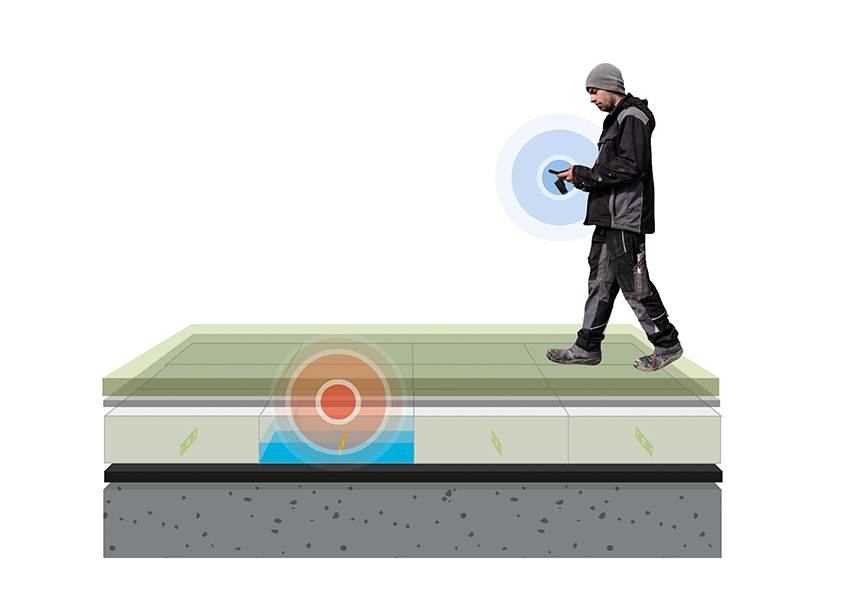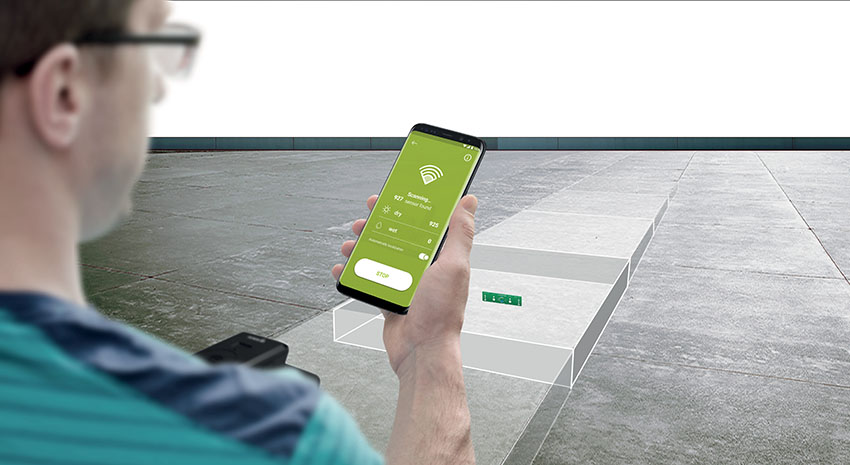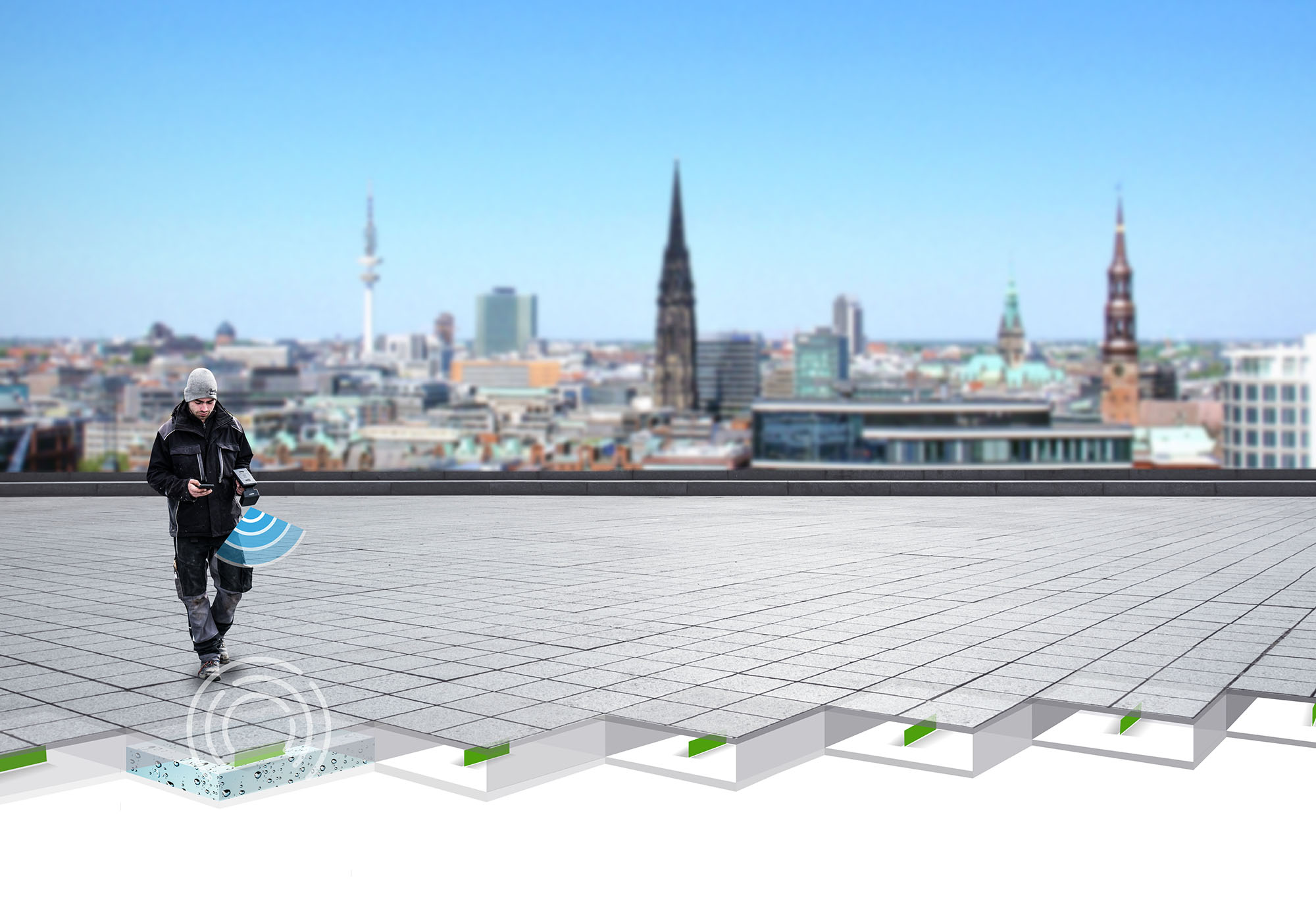HUM-ID is a Berlin-based manufacturer of battery and wireless RFID sensors for building inspections. The company started in 2013 as the first company with this kind of technology and have already become the standard for flat roof leak detection. The intelligent sensors are maintenance-free and can be checked for wetness with a scanner device. For this pragmatic and, above all, cost-effective approach, the HUM-ID was awarded the Smart Construction Challenge Award at Bosch Connected World in 2019. Well-known companies such as Züblin, Siemens and Cisco are enthusiastic about the technology, which enables data-based damage prevention.
Easy Engineering: What are the main areas of activity of the company?
HUM-ID: The high flexibility, accuracy and signal strength enable an efficient and cost-effective leakage check – without having to open the roof. The wireless check for wetness and standing water is now also used in many other applications such as outside walls and critical spots in the flooring like wet cells and floor heating.
A new approach for our system is the use in combination with wood.
E.E: What’s the news for 2021 about new products?
HUM-ID: In spring of this year, we have launched a new App version 4.0, which allows the user to upload a picture of the area that needs to be checked during the control. In case the scanner detects a wet sensor, the user can mark the current location on the photo.
Another new application is our KD1 Sensor for wooden Constructions, which are particularly sensitive to wetness.
That timber constructions are more than just a hype, is shown by the bare figures: Across Germany, the proportion of houses with a predominantly timber construction increased to 17.6% of all building permits issued in 2017. In some areas the numbers are particularly high: around one in three construction projects is realized with the natural material. What began primarily in residential construction now also extends significantly to so-called “non-residential construction”: building types such as kinder gardens and recreational homes, but also commercial buildings, were already realized with wood at around 20% in 2016. And the trend is rising.

With its special fleece, our KD1 sensor is even more sensitive to wetness than our regular sensor WD1. Even the smallest drops of water, are already detected.
We want to support and show appreciation to our most important partners – the roofers.
That’s why we started this month to certify those companies, that have used our system successfully in the past.
They receive a HUM-ID partner certificate, and we list them in our wide network on our homepage. This allows our customers to find an experienced roofer nearby.
E.E: What are the ranges of products?
HUM-ID: The HUM-ID system consists of two components: a wetness detector – the sensor – and a reading device – the scanner. Both components can communicate with each other through different layers.
Our portfolio includes two different sensors – the WD1 and the KD1 sensor. Depending on the particular application, we recommend our customers either the one or the other.
E.E: At what stage is the market where you are currently active?
HUM-ID: The market of wetness protection for buildings is a relatively new market.
As one of the first German companies, producing products to protect roofs and other parts of the building, we’ve seen the market grow.
Wooden constructions are gaining in importance. We notice that safety systems to control wetness are becoming more and more important for those who must warrant for it. No longer limited to the roof, also the entire building like walls and floors need to be protected.

The realization of architects and contractors, that through small investments like our sensor system, a large damage or high costs can be avoided in the event of renovation, is increasing.
Another factor is an increasing demand for our products, not only in Germany but especially within Europe.
We receive more inquiries from e.g. Luxemburg, Rumania, Austria and Switzerland.
For this reason we are currently looking for a strong sales partner in East Europe.
E.E: What can you tell us about market trends?
HUM-ID: One important development of the market is the increasing demand for sustainability.
Our passive system works without cables or batteries and is therefore particularly resource-saving both during installation and operation. No power supply is needed. The most important environmental protection aspect of our system is included into our general product promise: Thanks to HUM-ID, water damage can be detected at an early stage and unnecessary remedial measures can be prevented. Regular, sensor-based monitoring of wetness in roofs, walls and floors can minimize one of the biggest environmental problems facing the construction industry.
Toxic gases can be generated during the disposal of insulations and building materials. Narrowing down to sections that require remediation, reduces costs and improves the environmental footprint.

E.E: What are the most innovative products marketed?
HUM-ID: We have a few open projects in the pipeline. One, that we can talk about in this interview, is the use of a drone for controls of big buildings and roofs. In the future our customers will be able to book this service independently, which includes a complete visual check-up of the critical spots, photographic documentation and of course the HUM-ID wetness report of the sensors.
E.E: What estimations do you have for 2021?
HUM-ID: We expect that the increasing demand for wetness control in buildings will continue and go up even more.
Furthermore, we are sure that our system becomes the standard for modern and contemporary buildings, their roofs and interior areas.

